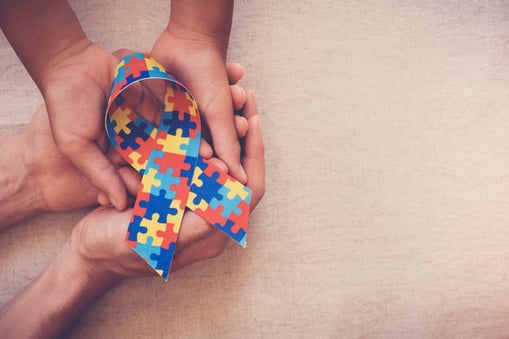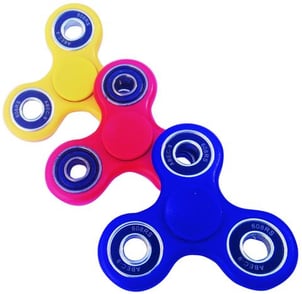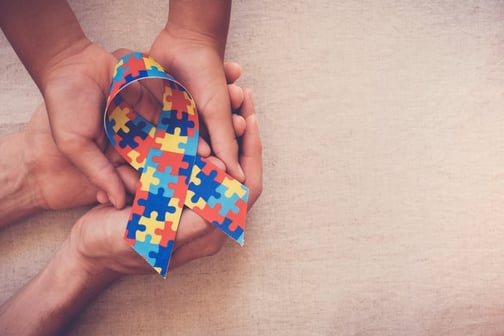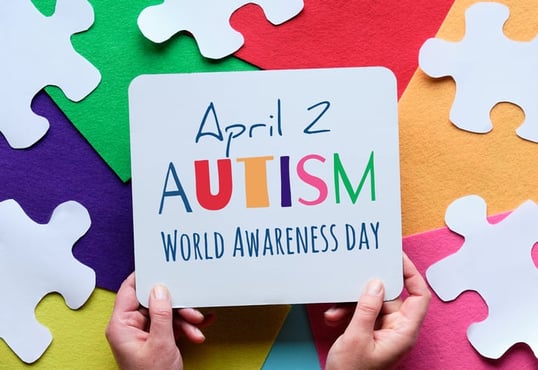9 Ways to Celebrate World Autism Day!
World Autism Day is celebrated each year on April 2. The United Nations member states recognize it as a day to acknowledge and advocate for the rights of autistic individuals around the world. The goal of World Autism Day is to increase awareness about Autism signs, symptoms, and information.
Here is how you can participate: Find ways to celebrate differences and promote kindness and inclusivity in your community, and encourage others to do the same.
More specifically, here are 10 ways to celebrate World Autism Day:
1. Learn about the history of autism
We’ve come a long way in the last 100 years in better understanding and treating autism. And year by year more research and treatment options are emerging for autistic children and adults.
1908 - The term autism was first used.
1938 - Donald Triplett, a young boy from Mississippi, met with pediatric psychiatrist Dr. Leo Kanner. Dr. Kanner described the boy as “autistic.” Now in his 70’s, Triplett is considered “Autism’s First Child,” or the first person formally diagnosed as autistic.
1943 - Child psychiatrist Dr. Leo Kanner writes a paper describing 11 children who were highly intelligent but displayed a desire to be alone and an attachment to “sameness” in schedules and day-to-day life. He used the description “early infantile autism."
1944 - Hans Asperger described autism as difficulty with social and communication skills and recognized a milder form of autism that he named Asperger's Syndrome.
1967 - Psychologist Bruno Bettelheim develops the theory that "refrigerator mothers," caused autism by not providing their children with enough love. (This theory was later debunked).
1973 - Dr. Ivar Lovaas created what we now call ABA therapy, which continues to be viewed today as the most effective therapy for working with autistic children to develop language and behavior skills.
1977 - Research on twins indicates that autism is primarily caused by genetics and biological differences in brain development.
1991 - The U.S. government classifies autism as a special education category and schools begin offering services to autistic children.
1994 - Asperger's Syndrome is added to the DSM, expanding the autism spectrum to include milder cases in which individuals tend to be more highly functioning.
2007 - “World Autism Awareness Day” was created by the U.N. in 2007.
2013 - The American Psychiatric Association recognizes autism as a spectrum.
2020 - STAGES® Learning releases the ARIS® Academic Readiness Intervention System, the first-ever comprehensive early autism curriculum making ABA therapy accessible for teachers and parents to help their children learn language and behavioral skills!

2. Raise awareness with what you wear
Put on your favorite blue clothes, grab an autism organization’s hat, or wear a shirt representing an autism organization to raise awareness. Wearing your support for autism awareness is a great way to make an impact on anyone that you encounter on the street, at the grocery store, and so on. Don’t have any autism awareness clothes readily available? Puzzle pieces are a universal sign of autism awareness -- buy some blue or puzzle piece ribbons at your local craft store to quickly make ribbons to wear.
3. Check out the work of famous autistic people
Some of your favorite celebrities and creators are on the autism spectrum. Here are four famous figures with autism -- are you familiar with their work?
- Satoshi Tajiri: Creator of “Pokémon” and video game designer.
- Daryl Hannah: American actress best known for her roles in Steel Magnolias, Wall Street, The Little Rascals, Kill Bill, and more.
- Alexis Wineman: Autism advocate, Miss America pageant contestant, and “Miss Montana.”
- Dan Aykroyd: Canadian actor, comedian, writer, producer, and musician best known for being part of The Blues Brothers and Ghostbusters.
4. Find sensory toys and tools that help
For autistic children, keeping focus can be challenging. Paying attention to a single task or set of tasks is a skill that can be developed over time.
Check out some of Stages Learning's sensory products:
-
Firm but squeezable and perfect for sensory or tactile stimulation, as a tactile roll, or a sensory brush. Sensory Light Up Bouncy Ball:
Sensory Light Up Bouncy Ball: -
Wiggle Cushion:
A perfect solution for children who have a tough time sitting still. A cross between a ball chair and a seat cushion, you can inflate it to stimulate balance and core work or deflate it to use it for movement. -
Wiggle Feet:
Fidgeting with feet allows excess energy to be expelled while sitting at a desk or in any chair helping achieve greater focus. -
Sensory Kit
This gives children (and adults!) a whole assortment of options to help get the wiggles out!
5. Support autism-friendly businesses and employers
There are many businesses actively working to be inclusive of autistic individuals. Many are actively seeking to hire neurodiverse employees and create more work opportunities for individuals with disabilities.
Here are some companies in your community that are autism-friendly:
-
AMC Theaters and FOCUS:
AMC Theaters provides multiple sensory-friendly movie showings each month, creating a theater with adjusted sound and light levels for individuals with sensory needs. AMC also created the Furthering Opportunities, Cultivating Untapped Strengths (FOCUS) program which is dedicated to developing employability skills for individuals with disabilities and hiring them. -
Microsoft’s Autism Hiring Program:
Inspired by an employee’s autistic son, Microsoft’s Autism Hiring Program was created as a job recruitment program to help autistic individuals develop career readiness skills. Participants focus on job capabilities and unique skills that they can offer companies. -
Walgreens REDI:
Walgreens Retail Employers with Disabilities (REDI) program works with local agencies to provide training to prospective employees in specific skill areas and then place them in settings that are supportive and appropriate for their skills. -
Royal Caribbean Cruise Lines and Autism on the Seas:
Royal Caribbean Cruise Lines has created autism-friendly cruises, including staff who are specially trained to support the needs of families with autistic children. Extensive dietary-responsive menus, and sensory-friendly relaxing and recreational areas are included onboard. -
Home Depot:
Home Depot has partnered with an organization called “Ken’s Krew” to recruit and train employees with disabilities. The program provides job matching, training, job coaching, and community support for employees.
6. Read books about autism
Books featuring autistic characters are an easy and entertaining way to introduce the topic of autism to your children, family members, friends, and your child’s peers. Books offer simple, accessible explanations and illustrations that can help children and others better understand autism.
Here are some children’s books that emphasize messages about friendship, community, and understanding:
“Ethan’s Story: My Life With Autism” (Ethan Rice): Written by eight-year-old autistic Ethan Rice. On his seventh birthday, Ethan decided that he wanted to share with classmates that he was autistic. This book is a collection of questions Ethan’s classmates asked him and the answers he gave. Ethan explains in his book what autism means to him and why he feels blessed that God made him that way.
“The Girl Who Thought in Pictures: The Story of Dr. Temple Grandin” (Julia Finley Mosca): Tells the story of Dr. Temple Grandin, an autistic woman. Dr. Temple Grandin’s story is told about how she thought differently than her peers. She went on to become a powerful voice in modern science, studying animals and publishing work relating to the humane treatment of livestock.
“Brotherly Feelings: Me, My Emotions, and My Brother with Asperger’s Syndrome” (Sam Frender and Robin Schiffmiller): Tells the story of Sam and his autistic brother Eric. The other kids don’t understand Eric because he acts differently than them. Sometimes, Sam gets embarrassed by the way his brother acts. But, when Sam sees Eric being bullied, he needs to make sure the other kids understand his brother is autistic and treat him with respect. In this book, Sam learns what it means to be a good sibling.
“Leah’s Voice” (Lori Demonia): The story of Logan and her older sister Leah, who is autistic. Logan has a playdate with a friend, Abby, who doesn’t understand Leah and tries to exclude her from playing. Logan doesn’t know how to explain to Abby that her sister is autistic. Logan becomes frustrated when she misses a movie because Leah is having a tough time in the theater. As the story goes on, Logan starts to see how Leah is being treated unfairly and learns how to explain to her friends why her sister acts the way she does and ways that she can be treated kindly.
“Since We’re Friends: An Autism Picture Book” (Celeste Shally): The story of Matt, who is autistic. Matt struggles in social situations but his best friend always helps him out, whether it’s during sports, reading, or talking about animals. This book captures the essence of friendship and helps children better understand their autistic peers.
7. Spread awareness in your community
Be an autism advocate and spread awareness in your community. Learning more about autism, showing your support, raising awareness, donating to charities and organizations that support autistic individuals, or participating in fundraisers are all simple ways to get involved and spread awareness in your own community. Reach out to family, friends, coworkers, and neighbors to get involved, too.
8. Spread kindness
Make the world a more inclusive place and spread positivity. Any act of kindness, big or small, can make an impact and is a powerful way to show others you care. A family member, friend, or person in your community will feel appreciated, loved, valued, and important. Give someone a call to say “hi,” write a friendly letter, or compliment a stranger. Kindness is contagious and may inspire others to do the same. In the spirit of inclusion, reach out and show kindness to those around you.
9. Read, watch, or listen to something created by a person with autism
First-person accounts, or perspectives directly from autistic individuals are important. They are a direct look into the experiences of someone diagnosed as autistic and allow others to gain a better understanding of one’s reality. In media, accurate representation is meaningful.
Check out these books (and also see our articles written by autistic young people):
- Look Me in the Eye: My Life with Asperger’s (John Elder Robinson): This memoir follows Robinson’s experiences growing up autistic. Through challenges in school, his career working with the rock band “KISS,” and building a family of his own, this humorous, moving look at life on the autism spectrum is a must-read.
- “Musings of an Aspie”: Meet Cynthia Kim. Author of her blog “Musings of an Aspie,” Kim documents her personal experiences navigating the world as an autistic woman. She documents anecdotes from her life and reviews resources for autistic individuals. Kim has also published articles in Autism Parenting Magazine, Thinking Person’s Guide to Autism and Autism West Midlands magazine.
- “Love on the Spectrum”: Are you a reality television fan? Enthusiastic about The Bachelor? Check out the Netflix series “Love on the Spectrum.” This docu-series follows seven autistic young adults as they explore dating, relationships, and finding love.
- “The World Needs All Kinds of Minds” TEDXTalk (Temple Grandin): Temple Grandin is an autistic American scientist, activist, and autism advocate. Watch her TEDXTalk where she talks about how her mind works: her ability to think in pictures, her problem-solving abilities, and how life as an autistic has benefitted her. The world needs all kinds of minds, and Grandin is an ambassador for inclusion.
- “Aspie World” (Dan Morgan Jones): Influencer, public speaker, and advocate Dan Jones is the host of “Aspie World,” a podcast about life experiences, motivational chats, and helpful tips for autistic individuals. Whether you are a parent or autistic yourself, work with autistic individuals, or are in education, medical, or the healthcare industry, there’s something to learn from Dan’s podcast.

In what ways are you celebrating World Autism Day on April 2?
This article is based on the following sources:
https://www.un.org/en/observances/autism-day/background
https://www.autism-society.org/get-involved/national-autism-awareness-month/
https://www.business-standard.com/about/when-is-world-autism-awareness-day
https://nationaltoday.com/world-autism-awareness-day/
https://www.psycom.net/autism-famous-people
https://www.menshealth.com.au/famous-people-with-autism
https://www.autismcommunity.org.au/famous---with-autism.html
https://www.verywellhealth.com/top-autism-friendly-employers-4159784
https://www.appliedbehavioranalysisprograms.com/companies-for-people-with-autism/
https://musingsofanaspie.com/about/
https://www.everydayhealth.com/autism/living-with/best-autism-aspergers-books/







